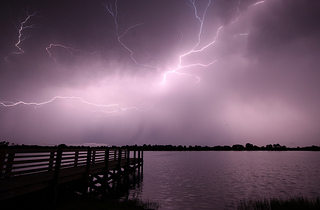Learn what is fact or fiction about lightning myths and how you can protect yourself from one of nature’s deadliest weapons!
You see the flash, you hear the thunderous clap, but you think you have plenty of time to get safely indoors.
Unfortunately, 28 deaths in 2012 (and three so far in 2013) were the result of lightning strikes to people staying outside too long and not taking the proper precautions to be safe. Five of those 2012 deaths were in Florida.
With National Lightning Safety Week happening June 23-29, we at Central Florida Health News have compiled some helpful information from the National Weather Service website that explores lightning myths and keeps residents safe in the state considered the “lightning capital” of the world.
Myth Versus Truth
We’ve all heard the so-called “truths” about lightning, but what do we really need to know about this force of nature?
First off, lightning does strike objects (which can include people) twice, but those objects are mostly tall, isolated and pointy like the Empire State Building in New York that is struck 100 times a year.
A thunderstorm doesn’t necessarily have to be overhead and causing rain for a person to be struck, as lightning can strike a person more than three miles from the thunderstorm’s center. “Bolts from the blue” can hit people between 10-15 miles away from a storm.
When seeking shelter while outside during a storm, do not consider a tree or lying flat on the ground as you can get electrocuted from ground current. Focus instead on continuing to move until you find shelter and try to stay away from metal objects such as bleachers, railings, or fences.
It’s safe to be in a car, though not because of the rubber tires but the metal roof and doors that circulates the lightning current. It’s encouraged to keep clear of the doors if at all possible to avoid getting electrocuted.
While in a house, stay away from anything plugged in and from windows. A thunderstorm’s wind power could cause objects to crash through a window and cracks in an old window could allow lightning to seep through.
Lightning can also travel through a house’s plumbing so it is wise to not take a shower or wash dishes while a thunderstorm is occurring.
The best advice to take is to seek shelter immediately when a thunderstorm is approaching. According to the National Weather Service (NOAA) website, more fatalities from lightning strikes happen when people take their time instead of quickly going indoors once they hear the first thunder clap.
CREDITS
story by BLAIR TOWNLEY
